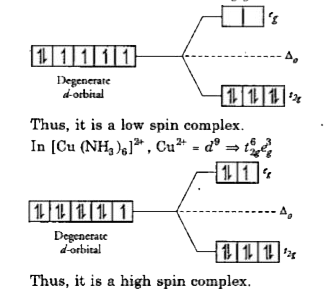Discuss the structure of following complexes on the basis of CFT.
(a)[Cu(NH3)6]3+(b)[Fe(CN)6]4−
As both the complexes have six ligands. So, they will have octahedral geometry. According to spectrochemical series, both CN− and NH3 being strong field ligand pair up the tag electrons before filling eg set.
In [Fe(CN)6]4−,Fe2+.=d6⇒t62ge0g

Thus, it is a high spin complex.
Similar Questions
Explain the geometry and magnetic nature of the following complex ions on the basis nof valence bond theory
(Cr(NH3)6]3+
(ii) [Fe(CN)6)]4
(iii) [FeF5]3−
(iv) [MnCl4)]2
(V) [Mncl(4)]2−
(vi) [Cu(NH3_(4)]2
View SolutionExplain the geometry and magnetic nature of the following complex ions on the basis nof valence bond theory
(Cr(NH3)6]3+
(ii) [Fe(CN)6)]4
(iii) [FeF5]3−
(iv) [MnCl4)]2
(V) [Mncl(4)]2−
(vi) [Cu(NH3_(4)]2
View Solution
Knowledge Check
The complex ions [Fe(CN)6]3− and [Fe(CN)6]4− :
AAre both octahedral and paramagneticBAre both octahedral and diamagneticCHave same structure but opposite magnetic characterDHave different structure but opposite magnetic character
Give the electronic configuration of the following complexes on the basis of crystal field splitting theory. [CoF6]3−,[Fe(CN)6]4− and [Cu(NH3)6]2+.
View SolutionGive the electronic configuration of the following complexes on the basis of crystal field splitting theory. [CoF6]3−,[Fe(CN)6]4− and [Cu(NH3)6]2+.
View SolutionGive the electronic configuration of the following complexes on the basis of crystal field splitting theory. [CoF6]3−,[Fe(CN)6]4− and [Cu(NH3)6]2+.
View SolutionDiscuss the nature of bonding in the following co-ordination complexes on the basis of valence bond theory :
(a) [Fe(CN)6]4− (b) [FeF6]3−
(c) [Co(C2O4)3]3− (d) [CoF6]3−
View SolutionGive the electronic configuration of the following complexes on the basis of Crystal field splitting theory.
[CoF6]3−,[Fe(CN)4−6 and [Cu(NH3)6]2+
View SolutionCalculate the effective atomic number of the metal atoms in the following complexes / complex ions.
(A)[Cr(CO)6] (b)[Fe(CN)6]3− (c)[Co(CN)6]4− [Ni(NH3)6]2+
[Cr=24,Fe=26,Co=27 and Ni=28 as atomic numbers]
View SolutionCalculate the effective atomic number of the metal atoms in the following complexes / complex ions.
(A)[Cr(CO)6] (b)[Fe(CN)6]3− (c)[Co(CN)6]4− [Ni(NH3)6]2+
[Cr=24,Fe=26,Co=27 and Ni=28 as atomic numbers]
View Solution
